Reykjavik is the capital of Iceland. It is situated on the south west coast. 37% of Icelands total population of 389,000 live in Reykjavik. Keflavik International Airport is about 45 minutes from the city center. International flights land here mainly from the US and other European countries. You can see planes fly over the harbour at all times, from the nearby Reykjavik domestic airport.
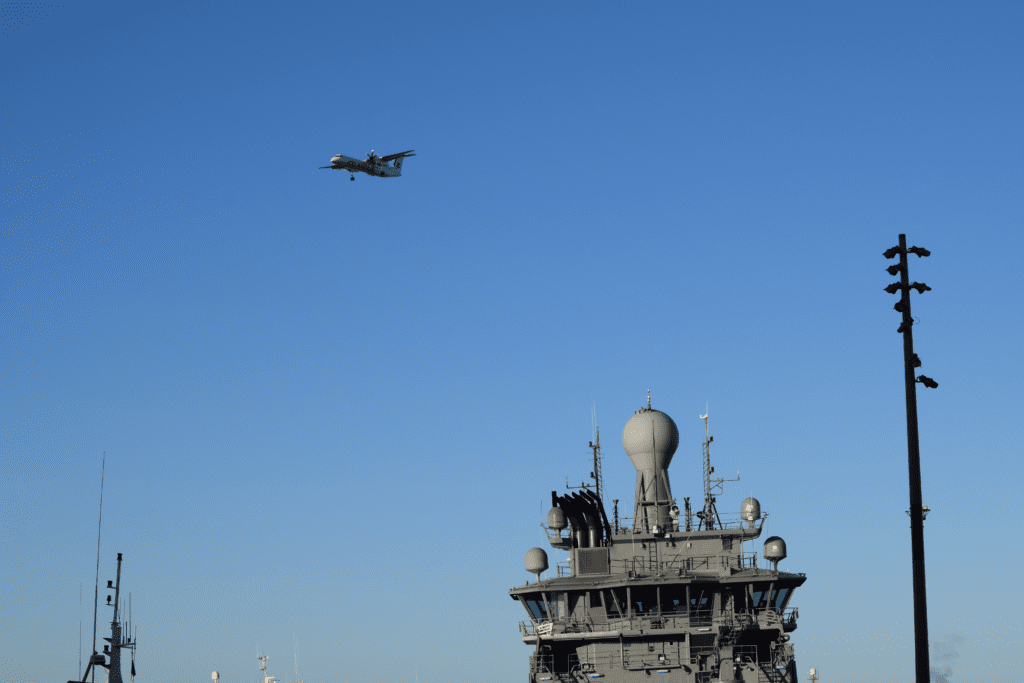
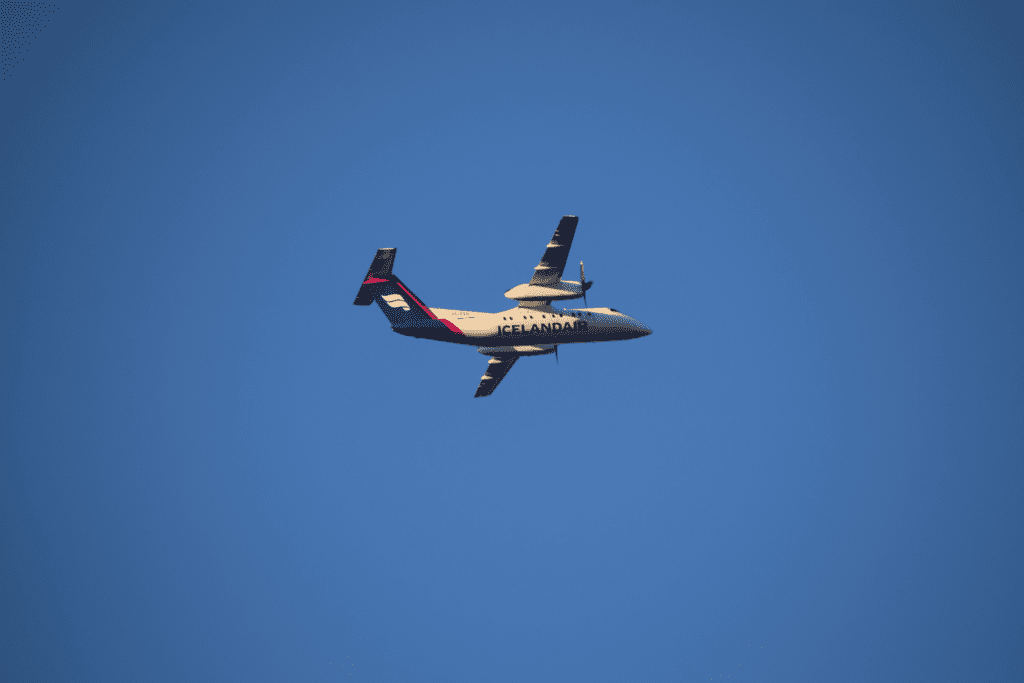
The drive from Keflavik airport takes you through the countryside and you see straight away that this is quite a flat country. You will also see the diverse colours in the landscape, from the green moss and grass to the brown gravel and of course the black volcanic rock.
The airport shuttle stops at the main bus terminal and you can then take a smaller bus to a stop near your accommodation. A one way ticket costs approximately 5,000 ISK (€33 or $37), which includes the transfer to the bus stop. Tickets can be purchased online, on Icelandair flights and at the airport. The local bus stops are also used by tour companies, making it very convenient when going on a tour.
The local currency is Icelandic Krona. At the time of travelling 1 ISK was equal to €0.0066. To make it easy, I multiplied the first number by 7, to calculate an approximate Euro equivalent. So 4,000 ISK was close to €28. Credit cards are widely accepted and there are lots of cash machines (ATM’s) available to withdraw cash for small purchases.
I stayed at the FossHotel Reykjavik, which is the largest hotel in the city. It is located very close to the city center. The main harbour is a 15 minute walk along the picturesque sea front.
My Walking Tour
I suggest you walk around Reykjavik, when you first arrive and familiarise yourself with the city. It is a walkable city with several pedestrianised streets. It is also extremely safe as the crime rate in Iceland is very low. Most of the area is flat and when the streets do go uphill, the incline is very gradual. I walked along the seafront first passing the “Sun Voyager” sculpture. It is described as “a dreamboat and an ode to the sun”. It was completed in 1980 and the artist wanted it to convey the promise of undiscovered territory, a dream of hope, progress and freedom. It is a very popular place to watch the sunrise and sunset.

I then walked further to see the “Harpa” concert and conference hall. This very striking glass fronted building is the home of the Icelandic Symphony Orchestra, the Icelandic Opera and the Reykjavik Big Band. I wasn’t able to see a performance, but I did have a glass of wine at the ground floor bar to sit and enjoy the view.


After leaving “Harpa” you can walk through the main shopping district which has lots of global brands as well as Icelandic shops. The streets are all pedestrianised with lots of places to stop for a coffee along the way. At the end of the street you can cross over to what appeared to be the older part of town. The Laugavegur district has lots of shops, cafes and bars and has a more bohemian feel to it, than the glitzier shopping area near the harbour. To the right you will come to the brightly coloured Skolavordustigur area with its distinctive rainbow coloured street.

Hallgrimskirkja church
Right at the top, stands the majestic Hallgrimskirkja church. While this doesn’t have Cathedral status it is the largest church in Iceland. It took 40 years to build and its hexagonal pillars and center are said to resemble a volcanic eruption. You can visit the church free of charge. They do close it to tourists when religious services are being held but signs on the door show the opening times. The organ has 5,275 pipes and is spectacular. For a fee of 1,300 ISK (€8.70 or $9.40) you can go up to the tower via a small lift.



The main bells are on the first floor you stop at. They ring every 15 minutes for a very short time (way too short, I thought). A small flight of stairs then takes you to the viewing area where you get an amazing panoramic view of the harbour and city.
I wasn’t able to get a complete photo of this Church so I have shared a few of my favourites.


There are lots of restaurants, cafes and bars in this area so it’s the perfect place to go for Happy Hour or for dinner (recommendations below in the food section).
Happy Hour
Lots of bars and restaurants offer “Happy Hour”. Some will have a small selection of drinks at a reduced price i.e. one type of beer, wine or cocktail. Others will offer larger measures at the price of a smaller one. I didn’t see snacks provided free of charge anywhere. Happy Hour usually started at 3pm or 4pm but always finished at 6pm. There was a nice atmosphere in establishments during this time as locals and tourists mixed together.
Reykjavik City Card
This is available for 24, 48 and 72 hours duration. It costs €28, €42 and €56 approximately for each duration. You can’t download it online though. You receive a voucher after making payment online and you can then collect it at several locations (all City museums).
You can attend some museums free of charge and get small discounts on others. You can also use most buses free of charge. I didn’t purchase this as after researching it, I didn’t think it was beneficial to me. However, if you are only in the city for a few days and plan to attend lots of places within the time limit, I recommend it. I didn’t get a local bus at any time as I walked everywhere.
Perlan – Wonders of Iceland
There are lots of great museums in Reykjavik. If you only have a few days, I suggest you attend Perlan first. It took me about 30 minutes to walk there as it’s on the outskirts of the city on top of Oskjuhlid Hill. You leave the main street and walk through a short uphill wooded path which takes you to the back of Perlan. You can also take the 18 bus from Hlemmur (see below).
I had booked my ticket online and with the small discount it cost 4,890 ISK (€33 or $35). You select the time to arrive as they do restrict numbers entering the facility.
The dome shaped building is very striking and is situated with a great view overlooking the city. The dome sits on 6 water tanks. There is a separate turnstile entrance for prepaid tickets. As well as checking the QRD code on my ticket, they confirmed my name on their system. I was given an armband which had a QRD code to allow access to the main areas.

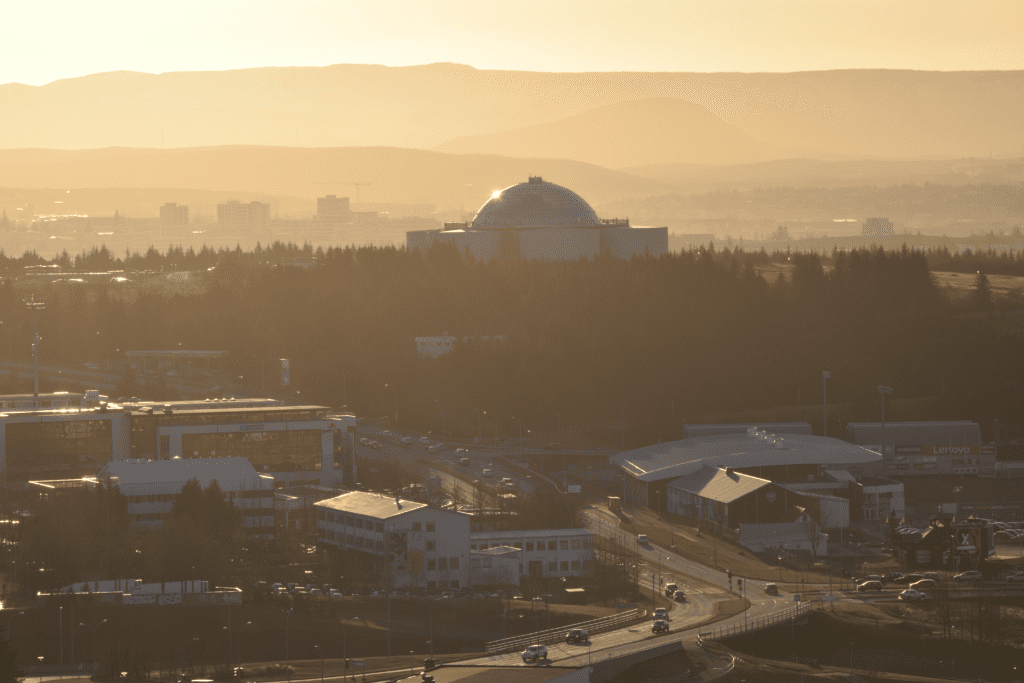
After leaving my coat and bag in the locker area, I decided to go to the Volcano show first. It started every 15 minutes and there was only one other person in the theatre when I arrived. Her friend had stepped out to take a phone call just before the show started and she wasn’t allowed come in once it had commenced. It lasted 6 minutes and while it didn’t have audio, the pictures of the volcanos and landscapes were just amazing. I do suggest you make time to read the large signs in the entrance hallway before seeing this show.
I then went to the first floor and spent about an hour walking around “The Wonders of Iceland” exhibition. All signage was in English and Icelandic and it’s extremely detailed and informative. You get a great overview of the geographic landscape and it’s the first time I ever read about the positive impact of an Earthquake i.e. it’s contribution to the geothermal power system in Iceland.
There is a small sideshow in an open theatre explaining how Earthquakes occur. Do sit on the white seated map of Iceland as it simulates the feeling of a small Earthquake. I lived in LA for years so I have felt a real tremor before, but if you haven’t, this is a great way of feeling a “safe” one. Again this show had no audio and it lasted about 5 minutes.

The “Ice Cave” is also on this floor. You see a small video first and you then enter the cave. They allow small groups of less than 20 in every 10-15 minutes. I had been to a real ice cave a few days before so this was a little wasted on me. But the other people there were really enjoying it. They were taking lots of photos, walking into the small enclosed areas and feeling the various surfaces within the cave.
The 2nd floor has “The Water in Iceland” exhibition. This again is extremely informative with lots of signs, interactive exhibitions, photographs and touch screens to learn more.
I then went to the Northern Lights show, which starts every 30 minutes. This is in the largest theatre on site and is really spectacular. The shape of the seating arrangement and screen is really geared to give a panoramic view of the lights.
Upstairs there is a restaurant, gift shop and ice cream shop. I had tomato soup for lunch and it was a large portion. The restaurant has great panoramic views of the city. After eating I walked around the outside area to take photographs and enjoy the views of Reykjavik, the harbour and the surrounding areas.
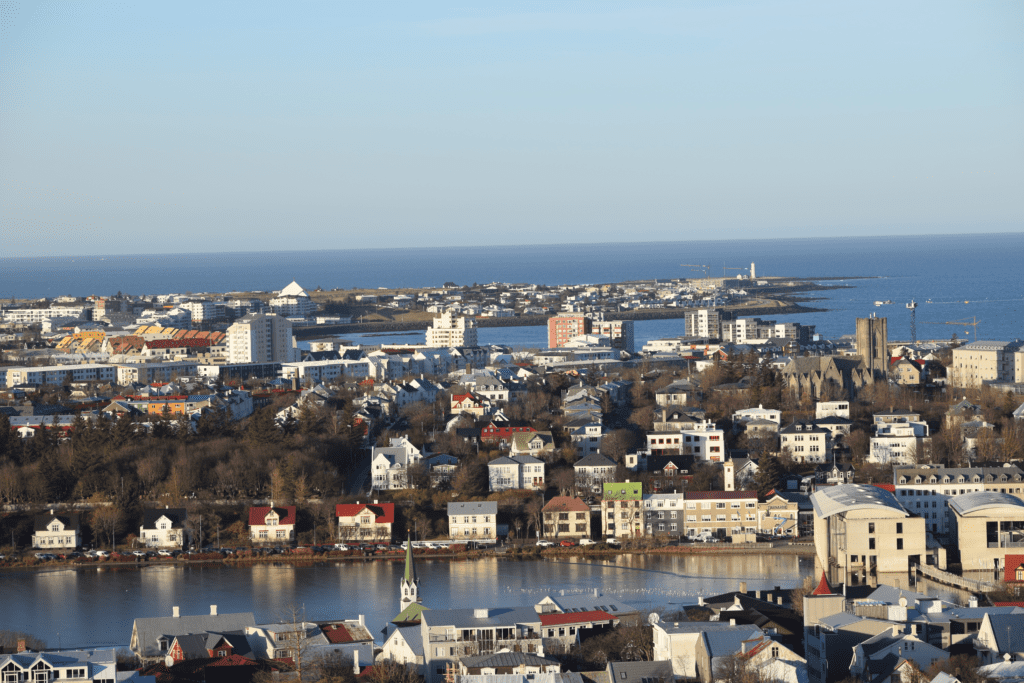

I spent over 4 1/2 hours visiting Perlan and I think you need that amount of time to really see everything comfortably. I was talking to an American couple one night at a restaurant and they told me their tour allowed them 45 minutes. You can’t do this place justice in that amount of time. Even if you are not a great fan of museums, I think most people, of all ages, will enjoy a visit here.
Aurora Museum
This museum is situated at the harbour and is the most detailed overview you will get anywhere on the Northern Lights.

The entrance fee costs 2,900 ISK (€19.30 or $20.80). The tour company I booked to see the Northern Lights, cancelled on two occasions due to fog. They recommended visiting this museum and gave a code to request a 10% discount.
The museum has lots of signs (in English and Icelandic) explaining all the aspects of the Northern Lights. It traces back to when they were originally discovered. You learn how to capture the perfect camera shot of the real thing. After spending about an hour in the museum, you are given a complimentary hot beverage in the cafe (tea or coffee). Then you get to experience the best bit, as you are given AI glasses to experience the Aurora Borealis yourself.



I really enjoyed this museum and think they do a great job of educating you in an interesting way about this amazing natural phenomenon.
National Gallery of Iceland
The entrance fee costs 2,200 ISK (€14.50 or $16) which also allows you access to 3 Museums. The others are “The House of Collectors” and “The Home of an Artist”. You were given a postcard at the first one and they mark the museum off as you attend them. There is no time limit on when you visit all 3. I went to the Home of the Artist, on my 2nd week in Reykjavik.
This impressive white building is very near the center of Reykjavik and I would assume is busy during high season. The interior is really beautiful with its central arch over the marble staircase. There are 4 floors and you are recommended to start on the top floor.

The top floor is dedicated to “Air”. It has various exhibits on “The Current State of Icelands Glaciers”. I was fascinated by this as it shows that several have changed more in the past 30 years than in the prior 100. They had great photographs and 3D interactive displays to showcase this.
The 3rd floor is dedicated to “Land”. It had 15 photos showing the same section of the land changing over a 20 month period. This was very interesting. It showed the differences in size and colour of the foliage and the impact of seasonal changes. Some of the interactive displays on this floor were not working.
The 2nd floor is dedicated to “Water”. It had several photographs showing cars and buses in trouble in rivers. You could sit into a traditional wooden boat and row it to see exactly how they work. This floor also had lots of paintings and photographs of waterfalls and the rivers throughout Iceland.
The 1st floor referred to as “Metaphysical” had a wide array of drawings and sculptures.
I was alone in this museum and spent about 90 minutes on my visit, which I thoroughly enjoyed.
The House of Collectors
This museum is a 7 minute walk from the National Gallery. It is right beside the river. It was my least favourite of the 3 museums but it was the busiest. It is situated in a lovely part of the town though, as it overlooks a river. The coloured houses on the opposite bank are really lovely and their reflections in the river was beautiful.

The ground floor exhibition is all about “Trolls’ which are a huge part of Norse Mythology. There are several mirrors where you see yourself transformed into a troll. These are similar to the quirky mirrors you often see at Fairgrounds which change your body shape. I am sure children really enjoy these troll mirrors.
The main exhibition has a wide array of art from various Icelandic artists. I wasn’t familiar with any Icelandic artist so it was interesting to see their work.
In the middle of the room, there are 6 old fashioned TV’s with headphones attached to each one. You can listen to various sounds as you watch images. These include walking on gravel, through an ice pond and the grass blowing in the wind. It’s really quite bizarre.

This floor had 3 large sculptures called “Macho” sculptures. A projector imposed some 3D imagery onto them which was interesting to see in the light.

I spent about 45 minutes in this museum. It did have another section for children, a gift shop and a cafe.
The Home of an Artist
This museum, as the name says, is in the former home of the Artist. The artist is Asgrimur Jonsson and he is credited as the first Icelandic artist to actually make a living from his art. His home is on a residential street about a 20 minute walk from the harbour. On the ground floor you can see his living room and bedroom. As well as his furniture, lots of his personal items are on view including his glasses and pocket watch.
His studio is upstairs. This is a beautiful room which is the full-length of the top floor with fabulous light from the numerous windows.

You can see straight away why this space inspired him. Lots of his work is on display including several depicting the seasons from his widow (one is below). His paintings are really lovely with lots of colour and depth.

Asgrimur died in 1958 and he didn’t have any heirs, so he donated this home to the state to be used to showcase his work. I really enjoyed my visit to this unique museum. I was there alone and the American curator (who now lives in Reykjavik) told me I probably would be the only visitor that day. I thought it was a shame that they don’t get more visitors, especially as its admission is paired with the other 2 museums.
Food and Drink
I was surprised at how many cosmopolitan restaurants there are in Reykjavik. These included Thai, Indian, Chinese, Italian, Middle Eastern and Nepalese. My favourite was the Himalayan Spice Restaurant on the pier. I highly recommend the Vegetarian Nepalese Thali, (1st picture below). They also have a lamb and chicken alternative.

As I am vegetarian, I can’t recommend any of the unique Icelandic specialities such as fermented shark, smoked lamb and dried fish. They also eat Rudolf ! I went to a food hall one afternoon for happy hour and when I asked what snacks they had that day, I was told the dish of the day was “Reindeer”. I didn’t hear how it was cooked and served as I got a shock when they said “reindeer”. The server was very amused when I declined saying I was vegetarian.
I did enjoy my food during my visit and the images below are some of the great dishes I had. This is an expensive city to eat out in and I usually paid at least €30 per meal for one main course, a beverage and a coffee.



I didn’t purchase one bottle of water during my visit. It was always available at cafes and restaurants. There were either bottles left on the tables or you could pour yourself a glass from a serving area. I was always able to fill my water bottle at my hotel or in a cafe. I loved this as hate the single use plastic culture which has become so commonplace and it also saved me some money.
Skyr is the Icelandic yogurt and is considered healthier than Greek yogurt. It contains more protein. Very few food products made in Iceland are imported, so while you may see “Icelandic Yogurt” sold elsewhere, it won’t have been made in Iceland. I highly recommend you try Skyr when visiting Iceland.
Icelanders eat Ice Cream all year around and there are lots of local creameries around the country. Several of the attractions I visited had Ice Cream parlours and there was a great selection of deserts on all menus.


The Hlemmur Food Hall in Reykjavik is well worth visiting for a drink or a meal. It is situated in a building that used to be the main bus terminal. Lots of buses still stop at the location. I expected it to have fast food style restaurants and was surprised at the quality of the food and drink. It is quite expensive but worth a visit. Also, locals frequent it and due to the communal seating either at the bar or tables, this was where I had conversations with locals on two occasions. Some of the places close at 9pm and others are open until 11pm.
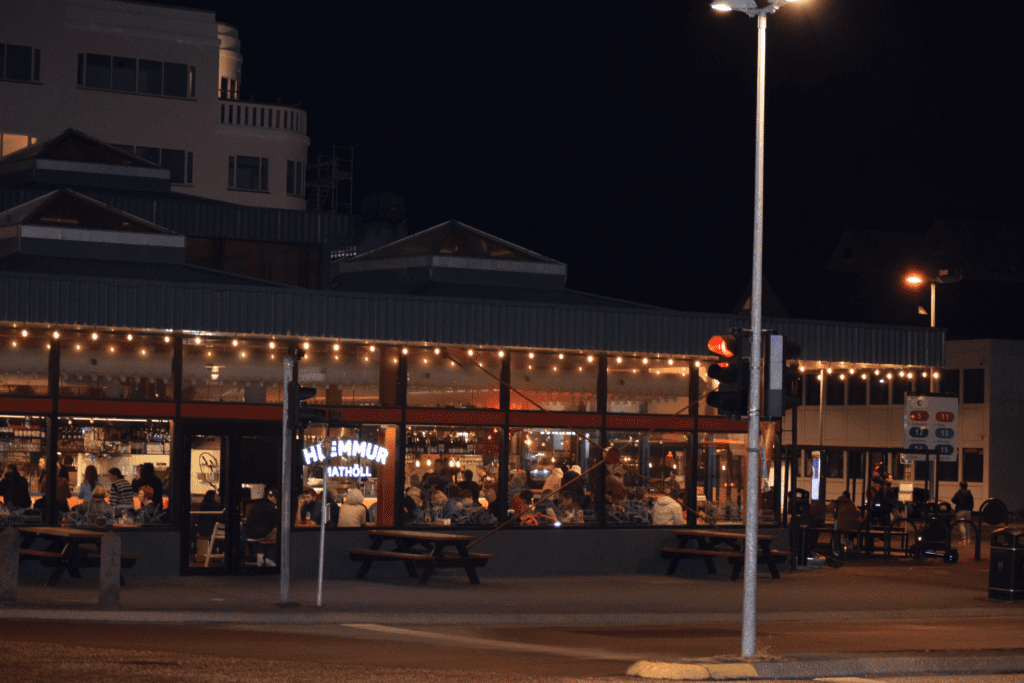
Beer Tasting at Micro Bar
Icelanders like to enjoy an alcoholic beverage. There are lots of local breweries and whisky distillers throughout the country. You will see beer and whisky available in lots of locations. If you are partial to one or the other, I strongly suggest you attend a tasting. I also hope you get an enthusiastic bar person to pour for you !
I don’t drink whisky and prefer wine over beer. Wine is very expensive in Iceland. I went to a beer tasting at Micro Bar during Happy Hour. It cost 4,000 ISK (€26 or $28) for a sample of 5. I asked the barman to select the 5 for me from his selection of 14. He did a great job giving me lots of variety. I had an IPA, 2 lagers, a stout and a fruit bitter. They also have a whisky tasting offering.

I tried some Icelandic beers in other locations. They have lots of local ones including Viking and Einstok. They had “seasonal” varieties for Christmas which several bar staff told me is due to the Danish influence. I tried a few of these and I loved them all as they had a lot of spicy flavouring. Beer averaged between 1,400-2,500 ISK per serving (usually 0.4L). This is between €9-€16 and $10-$18.



Shopping
All tourists can claim a percentage of VAT i.e. sales tax, back on certain purchases. Some shops will advertise that they don’t charge the tax and others will give you the documentation to claim tax back. This is only available on items costing more than 6,000 ISK (€42 or $44) . The standard rate is 24% and you can claim back between 12.5% and 14%. You get the receipt and a duplicate sales receipt at point of sale. It will show you how much you can claim back. You then complete some details (name, passport number, how you want to be reimbursed etc) and submit the paperwork at a desk before you go through security at the airport. Be careful that you do this as usually these facilities are after you pass through security. They review the paperwork and stamp it. I submitted some and it was a quick process to hand in the documents at the airport. My refund was paid into my account 16 days after I returned from Iceland.
While Iceland is an expensive country to shop in, the quality of winter clothes and hiking attire is really exceptional. After looking in a few shops, I thought “Icewear” had the best selection, at affordable prices. I bought some waterproof pants and hiking boots, which I hope I will have for many years and many miles !!
Final Thoughts !
I met several tourists who were visiting Reykjavik for a weekend and you certainly can see a lot in 2 days. I was there for 12 days (6 days at a time) so I had a lot of time to see things at a leisurely pace. I also went on the Golden Circle Tour from Reykjavik (see post on that), which requires a full day.
I will be posting another blog reviewing all the other things I did. This combined with this blog, will be a guide for the tourist with more time to spend in this unique and amazing city !


